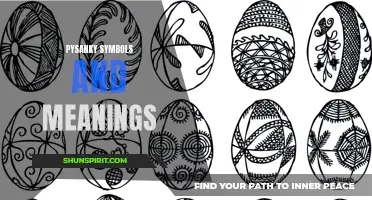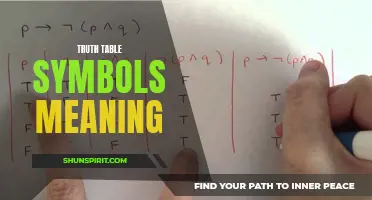
Pictures of symbols have been an integral part of human culture for centuries. From ancient hieroglyphics to modern emojis, symbols have played a crucial role in communication and storytelling. But what makes these pictures so intriguing is their hidden meanings. Each symbol carries a story, a belief, or a concept that transcends language and connects us to a larger collective consciousness. Whether it's the yin and yang symbol representing balance or the peace sign symbolizing harmony, these pictures have the power to convey complex ideas in a simple yet profound way. So join me on a journey as we explore the rich world of symbols and unravel their hidden meanings through captivating pictures.
What You'll Learn
- What are some commonly used symbols and their meanings?
- Where can I find pictures of symbols and their meanings?
- How can symbols be used to convey meaning in different cultures?
- Are there any symbols that have different meanings in different contexts?
- How can understanding the meaning behind symbols enhance communication and understanding?

What are some commonly used symbols and their meanings?
Symbols are powerful tools that have been used for centuries to convey specific meanings and messages. They can be found in various cultures, religions, and fields of study, and are often used as a form of communication and representation. Here are some commonly used symbols and their meanings:
- The Yin Yang symbol: This symbol represents the concept of balance and harmony. It consists of a circle divided into two halves, with one half being black and the other white. The black side represents Yin, which symbolizes darkness, femininity, and passivity, while the white side represents Yang, which symbolizes light, masculinity, and activity. The Yin Yang symbol emphasizes the idea that opposites are interconnected and interdependent, and that the existence of one is not possible without the other.
- The Om symbol: This symbol is considered sacred in Hinduism, Buddhism, and Jainism. It represents the divine sound of the universe, which is believed to be the essence of all creation. The symbol consists of three curves, a semi-circle, and a dot. The three curves represent the waking, dreaming, and deep sleep states of consciousness, while the semi-circle represents the illusion of Maya. The dot represents the ultimate reality and the essence of consciousness.
- The Cross symbol: The cross is one of the most widely recognized symbols and is associated with Christianity. It represents the crucifixion of Jesus Christ and his sacrifice for the redemption of humanity. The vertical line of the cross represents the connection between Earth and heaven, while the horizontal line represents the connection between people and their relationships with one another.
- The Ankh symbol: This symbol is an ancient Egyptian hieroglyph that represents life and fertility. It resembles a cross with a loop at the top. The Ankh symbolizes eternal life and is often depicted in the hands of gods and goddesses in ancient Egyptian art.
- The Lotus flower: The Lotus is a symbol of purity, enlightenment, and rebirth. It is deeply rooted in Buddhist and Hindu traditions and is often associated with spiritual awakening. The Lotus flower grows in muddy water but remains untouched by its impurities, representing the ability to rise above difficult circumstances and attain spiritual enlightenment.
- The Peace symbol: This symbol, also known as the peace sign, was created in 1958 by British artist Gerald Holtom as a nuclear disarmament symbol. It has since become a universal symbol of peace and anti-war movements. The symbol is an amalgamation of the semaphore symbols for the letters "N" and "D," which stand for "nuclear" and "disarmament" respectively. It has been widely adopted by various organizations and individuals advocating for peace.
- The Eye of Horus: This ancient Egyptian symbol represents protection, healing, and wisdom. It is commonly associated with the god Horus, who was believed to have the ability to perceive everything. The Eye of Horus is often depicted as a stylized eye with markings resembling the falcon, which was Horus' sacred animal.
Symbols have the power to convey complex ideas and emotions in a simple and universally understood manner. They have the ability to transcend language barriers and cultural differences, making them a powerful tool for communication and expression. By understanding the meanings behind these symbols, we can gain a deeper insight into different cultures and belief systems.
Decoding the Hidden Meanings Behind France's National Symbols
You may want to see also

Where can I find pictures of symbols and their meanings?
Symbols are a powerful form of communication that has been used by humans for thousands of years. Whether it's the peace sign, the yin and yang symbol, or the cross, symbols can convey complex ideas in a simple and visual way.
If you're interested in learning more about symbols and their meanings, there are several resources available to help you. One of the best places to find pictures of symbols and their meanings is through online image search engines. Websites like Google Images and Pinterest allow you to search for specific symbols and browse through a wide variety of images. Simply type the name of the symbol you're interested in, such as "peace symbol," and you will be presented with a range of pictures that depict the symbol along with information about its meaning.
Another great resource for finding pictures of symbols and their meanings is through online encyclopedias or reference websites. Websites like Wikipedia often include articles on various symbols, complete with images and detailed explanations of their meanings. These articles may also provide historical background and cultural significance of the symbols, giving you a deeper understanding of their context.
If you prefer a more interactive and engaging way of learning about symbols, there are also smartphone apps available that can help. Apps like Symbolab and Symbols by Sharefaith offer a collection of symbols with their meanings, allowing you to explore various symbols and their interpretations. These apps often include images along with explanations, making it easier to understand the symbols visually.
Additionally, books and libraries are great resources for finding pictures of symbols and their meanings. Look for books on symbolism or cultural history in your local library or bookstore. These books often feature a curated selection of symbols, accompanied by detailed explanations and illustrations. The advantage of using books is that they offer a more comprehensive and curated collection of symbols, allowing you to delve deeper into the topic.
In conclusion, to find pictures of symbols and their meanings, you can utilize online image search engines, reference websites, smartphone apps, and books. These resources offer a wide range of pictures, along with detailed explanations, allowing you to explore the rich world of symbolism. So whether you're studying a specific symbol or simply curious about the meaning behind a particular image, these resources are sure to satisfy your curiosity.
Decoding the Language of Military Symbols: Understanding Their Meanings and Significance
You may want to see also

How can symbols be used to convey meaning in different cultures?
Symbols play a significant role in conveying meaning in different cultures. They act as a visual language, representing abstract concepts, ideas, and emotions. These symbols vary across cultures and can be found in art, literature, religion, and everyday life.
One way symbols are used to convey meaning in different cultures is through religious or spiritual practices. For example, the cross is a symbol widely recognized in Christianity and represents the crucifixion of Jesus Christ and the redemption of mankind. In Hinduism, the "Om" symbol is considered sacred and represents the ultimate reality or consciousness.
Symbols also play an essential role in storytelling and literature. They can represent larger themes or ideas and add depth and layers of meaning to a story. For instance, the white whale in Herman Melville's novel, Moby-Dick, is not just a literal creature but also symbolizes nature's unpredictability and the struggle between man and the unknown.
In addition to religious and literary symbolism, cultural symbols can be seen in everyday life. National flags, for instance, are symbols that represent the identity and values of a nation. The American flag, for example, is made up of stars and stripes which symbolize the 50 states and the original 13 colonies, respectively.
Symbols can also be used to convey emotions and nonverbal communication. A smiley face emoticon, commonly known as :) or 😊, is used in online communication to express happiness or friendliness. In contrast, a red stop sign is universally understood as a symbol to halt or stop.
However, it is important to note that symbols may be interpreted differently across cultures. For example, while the color white may symbolize purity and innocence in Western cultures, it represents mourning and death in many Asian cultures. It is essential to be aware of these cultural differences to avoid misunderstandings or offense.
In conclusion, symbols play a critical role in conveying meaning in different cultures. They can be found in religious practices, literature, everyday life, and nonverbal communication. Symbols add depth and layers of meaning to various aspects of culture and contribute to the richness and diversity of human expression. Understanding and respecting these symbols in different cultures can enhance cross-cultural communication and appreciation.
Exploring the Rich and Powerful Meaning of the Thunderbird Symbol
You may want to see also

Are there any symbols that have different meanings in different contexts?
Symbols are powerful visual representations that hold various meanings and interpretations. Across different cultures and contexts, certain symbols may have distinct and even contradictory meanings. These symbols are often shaped by history, beliefs, and cultural associations, creating a colorful tapestry of interpretations. Here are some examples of symbols that have different meanings in different contexts:
- The Swastika: In Hinduism, the swastika is a sacred symbol representing good luck and auspiciousness. However, due to its adoption by the Nazi Party in Germany during the 1930s and 1940s, the swastika became synonymous with hate, racism, and genocide. Today, it remains a powerful symbol of division and bigotry, contrasting starkly with its original positive connotations.
- The Hand Gesture: Hand gestures can carry different meanings depending on cultural context. For instance, the "thumbs-up" gesture is generally seen as a sign of approval in Western cultures. However, in some parts of the Middle East, Latin America, and West Africa, it can be considered offensive or vulgar. Similarly, the "OK" hand gesture, formed by connecting the thumb and forefinger in a circle with the other fingers extended, is generally seen as a sign of agreement or satisfaction in many cultures. However, in certain contexts, such as some parts of Europe and Latin America, it can be interpreted as a vulgar or offensive gesture.
- The Crescent Moon: The crescent moon is often associated with Islam and is prominently featured on the flags of several Muslim-majority countries. It represents the lunar calendar used to determine the dates of Islamic holidays. However, the crescent moon is also used in various contexts outside of Islam. In ancient Mesopotamian cultures, the crescent moon was associated with the moon god Sin. In pagan traditions, it represents femininity, fertility, and the goddess Diana. Thus, the interpretation of the crescent moon symbol varies depending on the cultural and religious perspective.
- The Snake: The snake is a symbol that holds multiple meanings across different cultures. In some ancient civilizations, such as in Egypt, Greece, and Native American cultures, snakes were associated with healing, rebirth, and transformation due to their ability to shed their skin. However, in Judeo-Christian traditions, the snake is often associated with evil and temptation, as depicted in the story of Adam and Eve in the Garden of Eden. Similarly, in some African and Native American cultures, snakes are seen as bringers of wisdom and guardians of sacred knowledge.
- The Skull: The skull is a symbol that has contrasting meanings depending on the cultural and historical context. In Western cultures, the skull often represents death, mortality, and the macabre. It is commonly associated with Halloween and gothic aesthetics. However, in other cultures, such as Mexico's Day of the Dead celebration, the skull is a joyful symbol used to honor and remember deceased loved ones. It represents the belief that death is a natural part of life and should be celebrated.
Symbols are not fixed in meaning; rather, they evolve and transform over time as societies change. It is essential to consider the cultural, historical, and contextual significance of symbols to fully understand their meanings. By acknowledging the diversity of interpretations, we can cultivate a richer understanding of symbols and the varied ways they shape our world.
Understanding the Symbols in Sheet Music and Their Meaning
You may want to see also

How can understanding the meaning behind symbols enhance communication and understanding?
Symbols are a powerful tool in communication. They represent ideas, concepts, and emotions that can transcend language barriers and deepen our understanding of one another. By understanding the meaning behind symbols, we can enhance communication and promote better understanding.
One way symbols enhance communication is by creating a shared language. They allow us to communicate complex ideas in a concise and straightforward manner. For example, the peace symbol, a circle with three lines extending downward, universally symbolizes peace. This simple symbol can convey a powerful message without the need for words. By recognizing and understanding the meaning behind this symbol, we can quickly and easily comprehend its intent.
Symbols also serve as a tool for cultural expression. Different cultures use symbols to represent their beliefs, values, and traditions. For instance, the Chinese dragon is a symbol of power, strength, and good luck. Understanding the cultural significance of this symbol can help bridge cultural gaps and foster intercultural understanding. By being aware of the meaning behind symbols, we can avoid cultural misunderstandings and show respect for diverse perspectives.
Moreover, symbols can evoke emotions and create a deeper connection between individuals. The heart symbol is universally associated with love and affection. When we see this symbol, we instantly understand the emotion being conveyed. By recognizing the meaning behind such symbols, we can connect with others on a deeper level and cultivate more meaningful relationships.
Additionally, symbols play a crucial role in nonverbal communication. They allow us to convey messages without using words. For example, a thumbs-up gesture is widely recognized as a symbol of approval or agreement. By understanding the meaning behind this gesture, we can communicate our thoughts and feelings more effectively, even in situations where verbal communication is challenging or not possible.
Understanding the meaning behind symbols also promotes inclusivity and accessibility. Symbols can be particularly beneficial for individuals with communication difficulties, such as those with disabilities or language barriers. By using symbols that are universally recognized and understood, we can ensure everyone can participate in and understand the communication process.
In conclusion, understanding the meaning behind symbols enhances communication and understanding in several ways. Symbols create a shared language, allow for cultural expression, evoke emotions, facilitate nonverbal communication, and promote inclusivity. By recognizing and comprehending the meaning behind symbols, we can communicate more effectively, bridge cultural gaps, and foster deeper connections with others. Symbols have the power to transcend language barriers and enrich our understanding of one another.
The Hidden Symbolism of Easter: Unveiling the True Meaning Behind the Traditional Easter Symbols
You may want to see also
Frequently asked questions
Some popular symbols and their meanings include the infinity symbol, which represents limitless possibilities and eternity; the yin yang symbol, representing balance and harmony; and the peace symbol, which is widely recognized as a symbol of peace and anti-war.
Pictures of symbols and their meanings can be easily found on the internet. Many websites, such as symbolikon.com or freepik.com, offer a wide range of symbols and their corresponding meanings. Additionally, books or documentaries on symbolism may also include pictures and explanations.
Interpreting the meaning of a symbol can be subjective and may vary depending on the context or culture. One way to interpret a symbol is by researching its cultural or historical significance. Understanding the symbol's origin and cultural associations can provide insights into its meaning. Additionally, examining the symbol's visual elements and any accompanying text or context can also help in interpretation. It is important to remember that symbols can hold multiple meanings and can be interpreted differently by individuals.







